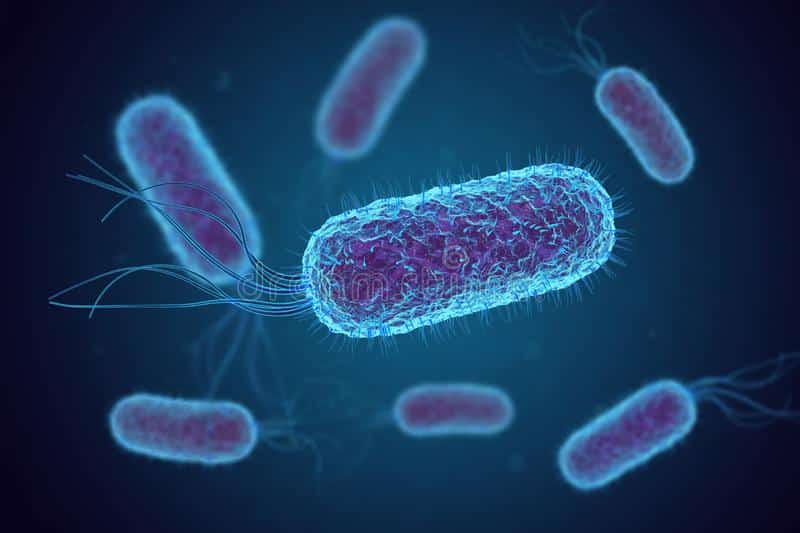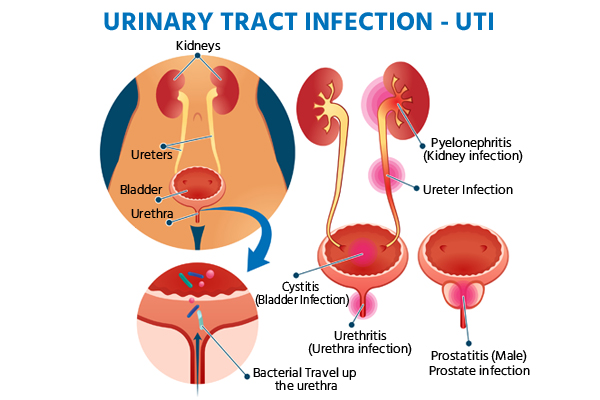Escherichia coli, or E. coli, is a versatile bacterium that can be both a helpful inhabitant of our intestines and a potential source of various infections.
In this comprehensive guide, we will explore the major infections caused by Escherichia coli in detail, including their symptoms, transmission methods, treatment options, and preventive measures. Understanding these infections is crucial for maintaining good health and well-being.
What is Escherichia coli?
Escherichia coli, commonly referred to as E. coli, is a fascinating bacterium with a dual nature. It’s primarily known for its role as a commensal bacterium, residing harmlessly in the human gastrointestinal tract.
However, certain strains of E. coli have evolved to become pathogenic, meaning they have the potential to cause infections.
The commensal or non-pathogenic strains of E. coli play a crucial role in our bodies. They are part of the natural gut microbiota, contributing to our overall health.
Commensal E. coli strains aid in digestion by breaking down complex carbohydrates and producing essential vitamins like vitamin K.
Pathogenic E. coli strains, on the other hand, possess specific virulence factors that enable them to cause infections.
These virulence factors can include adhesion molecules that allow the bacterium to attach to host cells, toxins that damage host tissues, and mechanisms to evade the immune system’s defenses.
What major infections are caused by Escherichia coli?

Preventive measures include:
Escherichia coli, or E. coli for short, is a type of bacteria commonly found in the intestines of humans and animals. While most strains of E. coli are harmless, some can cause serious infections, especially in people with weakened immune systems. Here are some of the major infections caused by E. coli
- Urinary tract infections
- Gastrointestinal infections
- Respiratory infections
- Wound infections
- Meningitis
- Hemorrhagic Colitis
1. Urinary tract infections (UTIs)

E. coli is the most common cause of UTIs, which are infections of the bladder, ureters, or kidneys.
Urinary tract infections are common and can be both painful and disruptive. Symptoms of UTIs are primarily related to the urinary system and may include:
- Frequent Urination: Individuals with UTIs often feel the need to urinate more frequently than usual.
- Burning Sensation: A burning or painful sensation during urination is a hallmark symptom.
- Changes in Urine: Urine may appear cloudy, bloody, or have an unusual odor. Lower Abdominal
- Discomfort: Many people with UTIs experience discomfort or mild pain in the lower abdomen.
- Back Pain: In some cases, UTIs can cause back pain, indicating a potential kidney infection.
Transmission
Understanding how E. coli causes UTIs is essential. The most common route of transmission is the transfer of E. coli from the gastrointestinal tract to the urethra, where it can ascend into the urinary system. Women are more prone to UTIs due to their shorter urethra, which provides easier access to bacteria.
Treatment and Prevention
Prompt treatment of UTIs is essential to prevent the infection from spreading to the kidneys or causing more severe complications.
Typically, healthcare providers prescribe antibiotics to eliminate the bacteria. It’s important to complete the entire course of antibiotics as prescribed, even if symptoms improve earlier.
Preventive measures for UTIs include:
- Hydration: Drinking an adequate amount of water helps flush out bacteria from the urinary tract.
- Personal Hygiene: Maintaining good personal hygiene, especially after using the restroom, can reduce the risk of introducing bacteria.
- Urinating Regularly: Avoid holding in urine for extended periods as it can promote bacterial growth in the urinary tract.
Recommended articles
2. Gastrointestinal infections
E. coli can cause several types of gastrointestinal infections, including diarrhea, bloody diarrhea, and food poisoning.
The bacteria are typically spread through contaminated food or water, and symptoms can range from mild to severe. In some cases, E. coli infections can lead to serious complications like kidney failure.
Gastrointestinal infections caused by E. coli can manifest with a range of symptoms:
- Diarrhea: Watery or bloody diarrhea is a common symptom, often accompanied by frequent bowel movements.
- Abdominal Cramps: Intense abdominal cramping can be painful and distressing.
- Nausea and Vomiting: Many individuals with gastrointestinal E. coli infections experience nausea and may vomit.
- Dehydration: In severe cases, persistent diarrhea and vomiting can lead to dehydration, which may require medical intervention.
Transmission
Understanding the transmission of gastrointestinal E. coli infections is crucial for prevention. Contaminated food and water are the primary sources.
Undercooked meat, especially ground beef, and unpasteurized dairy products are known culprits. Poor food handling practices can introduce pathogenic E. coli into the food supply, leading to outbreaks.
Treatment and Prevention
Treatment for gastrointestinal E. coli infections focuses on managing symptoms and preventing dehydration.
In mild cases, adequate hydration and rest may suffice. In severe cases, or if complications like hemolytic uremic syndrome (HUS) develop, hospitalization may be necessary.
- Food Safety: Practicing good food hygiene, such as thorough cooking and avoiding cross-contamination, is vital.
- Food Inspection: Ensure that meat products are properly cooked, and dairy products are pasteurized.
- Hand Hygiene: Regular handwashing, especially before handling food, can prevent the introduction of bacteria.
3. Respiratory infections
While less common than UTIs and gastrointestinal infections, E. coli can also cause respiratory infections like pneumonia and bronchitis.
These infections are more likely to occur in people with weakened immune systems and can be treated with antibiotics. Respiratory symptoms may include:
- Coughing: Persistent coughing is a common symptom.
- Shortness of Breath: Individuals may experience difficulty breathing.
- Fever: An elevated body temperature may accompany respiratory E. coli infections.
Respiratory E. coli infections can occur through inhalation of airborne droplets from an infected individual’s cough or sneeze. Contact with contaminated surfaces can also lead to transmission.
Treatment depends on the severity of the infection and may involve antibiotics. Preventive measures include practicing good respiratory hygiene, such as covering the mouth and nose when coughing or sneezing and avoiding close contact with infected individuals.
4. Wound infections
E. coli can also cause infections in wounds, especially in hospital settings. These infections can be difficult to treat and may require surgery.
Wound infections caused by Escherichia coli, though less common than other types of infections, can present with a variety of symptoms. These symptoms may include:
- Redness and Swelling: An infected wound often exhibits increased redness and swelling around the affected area. This is a result of the body’s inflammatory response to the infection.
- Pain: Pain at the site of the wound is typical, and it can range from mild discomfort to severe, throbbing pain.
- Pus or Discharge: Infected wounds may produce pus or other forms of discharge. Pus is a mixture of dead white blood cells, bacteria, and tissue debris.
It’s important to note that not all wounds infected with E. coli will display these symptoms, and the severity of the symptoms can vary.
Transmission
Wound infections occur when E. coli bacteria come into contact with open wounds or surgical sites. This can happen through various means:
- Contaminated Objects: Touching contaminated surfaces or objects and then touching an open wound can introduce E. coli.
- Improper Wound Care: Poor wound care practices, especially in healthcare settings, can lead to wound infections.
- Invasive Medical Procedures: Surgical procedures carry a risk of introducing bacteria into the body, including E. coli.
Treatment and Prevention
Treating wound infections caused by E. coli is essential to prevent complications and promote healing. Treatment typically involves the following steps:
- Wound Cleaning: Thoroughly cleaning the wound is the first step. This is often done with a mild antiseptic solution to reduce the bacterial load.
- Drainage: If there is pus or fluid buildup in the wound, it may need to be drained by a healthcare professional.
- Antibiotics: Depending on the severity of the infection, antibiotics may be prescribed. E. coli strains vary in their susceptibility to different antibiotics, so the choice of antibiotic will be based on culture and sensitivity testing.
- Wound Dressing: Proper wound dressing is essential to keep the wound clean and promote healing. The type of dressing used will depend on the wound’s characteristics.
Preventive measures to reduce the risk of wound infections include:
- Hand Hygiene: Practicing good hand hygiene is crucial, especially for healthcare providers and individuals caring for wounds.
- Sterile Techniques: In healthcare settings, maintaining sterile techniques during invasive procedures and wound care is essential.
- Proper Wound Care: Individuals with open wounds should follow proper wound care protocols, including keeping the wound clean and covered.
- Vaccination: In some cases, vaccination against certain E. coli strains may be recommended, particularly in healthcare settings or for individuals with specific medical conditions.
Wound infections caused by E. coli can vary in severity, with mild cases responding well to home care and more severe cases requiring medical attention.
Timely and appropriate wound care is essential to prevent complications such as cellulitis, abscess formation, or the spread of infection to other parts of the body.
Meningitis
In rare cases, E. coli can lead to meningitis, an inflammation of the protective membranes covering the brain and spinal cord. Symptoms may include:
- Severe Headaches: Meningitis often presents with intense headaches.
- Neck Stiffness: Individuals may experience difficulty moving the neck due to stiffness.
- Fever: An elevated body temperature is common.
- Altered Mental State: Changes in mental clarity or consciousness can occur.
Transmission
E. coli meningitis is often associated with neonatal infections, where the bacterium can be transmitted from mother to newborn during childbirth.
In adults, it’s less common but can occur as a result of other infections spreading to the meninges.
Treatment and Prevention
Prompt medical attention is crucial for treating E. coli meningitis. Treatment typically involves antibiotics.
Preventive measures include adequate prenatal care to reduce the risk of transmission to newborns and infection control measures in healthcare settings.
Understanding the diverse manifestations of E. coli infections and taking appropriate preventive measures can significantly reduce the risk of encountering these illnesses.
Vigilance, good hygiene practices, and timely medical care are essential in managing and preventing E. coli infections across various body systems.
6. Hemorrhagic colitis
Hemorrhagic colitis is a severe form of E. coli infection, primarily associated with E. coli O157:H7. It presents with distinct symptoms:
- Bloody Diarrhea: This is the hallmark symptom, and the presence of blood in stool is often alarming.
- Severe Abdominal Pain: Intense abdominal pain accompanies the bloody diarrhea.
- Kidney Problems: In some cases, particularly in children, hemorrhagic colitis can lead to kidney problems, such as HUS, which can be life-threatening.
Understanding how E. coli O157:H7 spreads is crucial for prevention.
This strain is often transmitted through the consumption of contaminated food, especially undercooked ground beef and unpasteurized milk.
Cross-contamination during food preparation is another common route.
Hemorrhagic colitis doesn’t have a specific treatment, and antibiotics are generally not recommended as they may worsen symptoms.
Supportive care, including rehydration and monitoring for complications, is essential.
Preventive measures include:
- Safe Food Handling: Ensuring meat, especially ground beef, is cooked thoroughly and practicing proper food safety measures can prevent infections.
- Avoiding Raw Milk: Unpasteurized milk and dairy products should be avoided, especially by vulnerable populations like young children and the elderly.
What Next?
Conclusion Escherichia coli is a versatile bacterium that, while often harmless, can cause various infections, ranging from urinary tract infections to severe conditions like hemorrhagic colitis and meningitis.
Understanding the symptoms, transmission routes, treatment, and prevention of these infections is vital for safeguarding your health.
Practicing good hygiene, safe food handling, and seeking prompt medical attention when needed can significantly reduce the risks associated with E. coli infections.
By staying informed and taking preventive measures, you can protect yourself and your loved ones from the potential harm caused by pathogenic E. coli strains.
